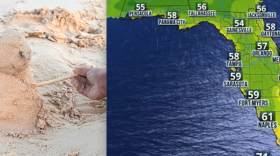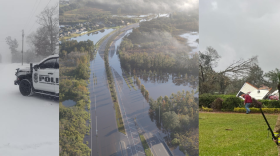Neil Lynch started his Saturday morning like any other: He stopped his car at Belleair Beach, griped about the hourly parking fee and set off on a 5-mile walk.
He usually brings his polarized sunglasses and walks with his neck craned toward the water, watching fish swim along the shallow shoreline.
But this weekend, most of the fish he spotted weren’t in the water. They were dead on the beach.
Lynch said he counted about 200 filefish washed up during his walk. Ocean scientists say scorching Gulf of Mexico water temperatures are likely to blame.
“They never stopped,” Lynch said. “The whole walk I just kept seeing them.”

The Gulf of Mexico is experiencing record-hot average water temperatures this summer, bringing coral bleaching and fish kills to the Florida Keys. As the heat has crept to Tampa Bay, residents are starting to see and feel the effects.
During July, average water surface temperatures in the Gulf of Mexico ran nearly 2 degrees Fahrenheit above normal. That’s the highest on record, according to an analysis provided by Matthew Rosencrans, the lead hurricane season outlook forecaster at the National Oceanic and Atmospheric Administration.
Some parts of the gulf are running hotter than that. Offshore of Tampa Bay and the Louisiana coast, for instance, sea surface temperatures are more than 5 degrees hotter than normal. (Inside Tampa Bay itself, water south of the Gandy Bridge topped out over 100 degrees on July 26.) A steamy gulf is not only taking a toll on marine life, it also means there’s more fuel available for hurricanes as the storm season enters high gear.
“You always think of the Gulf of Mexico as being warm this time of year during the peak of hurricane season,” said Brian McNoldy, a senior research associate at the University of Miami’s Rosenstiel School of Marine and Atmospheric Science.
“But it’s never been this warm.”
“A concern for hurricane season”
In the world of hurricanes, every degree counts. So when water is super-heated, forecasters pay attention — especially when we’re nearing the height of storm season.
Last week, federal ocean scientists increased their hurricane season prediction to include more storms. One of the main reasons: Record-breaking Atlantic ocean temperatures are counterbalancing the ongoing El Niño, which typically weakens hurricanes.
In the Gulf of Mexico, higher-than-normal temperature averages could be a boost for a storm to form on its own, or they could be a green light for a storm that enters into the gulf to maintain or grow its intensity.
“If conditions were iffy for something to develop, this could be the nudge it needs,” McNoldy said.
There’s a general understanding in hurricane science that wind speeds are expected to increase about 5% for every 1 degree Celsius increase in tropical ocean temperature, according to Jeff Masters, a hurricane scientist formerly with the National Oceanic and Atmospheric Administration.
Each degree increase equates to about 50% more storm damage from heightened storm surge, higher wind and rain destruction, Masters said.
“If we do happen to get something loose in the gulf, we’ve got a whole lot more energy there available for it to cause destruction,” Masters said. “When waters are hot enough to feel like a hot tub, it’s a concern for hurricane season — because hurricanes feed off of that heat.”

Hurricanes get their energy when winds blow over the top of the ocean’s surface and pull moisture and heat from the ocean. The warmer the sea surface, the more moisture and energy a storm can pull out of the ocean initially, according to Rosencrans.
Conditions are most ripe for a storm to intensify when deeper ocean water is also warm, not just at the sea surface. But overall, surface temperatures are a good predictor for the entire hurricane season because they’re tied to the winds above. That offers a glimpse into the broader ocean-atmosphere system at play, Rosencrans said.
With global climate change, fueled by human-caused greenhouse gas emissions, ocean temperatures in the main region where hurricanes form are running about a half-degree hotter now than they were 20 years ago, Rosencrans said.
Water temperatures, of course, can go up and down from one year to the next, depending on weather patterns, wind speed and direction, and whether the atmosphere is trapping hot ocean air. But what matters is the trend, McNoldy said.
“These ups and downs are occurring on an upward trend,” he said. With climate change, “it makes these super warm, anomaly events more likely to happen.”

Hot temps throw wildlife out of balance
The current gulf waters are the hottest Capt. Joe Genovese has ever experienced.
Genovese has run his fishing guide business, Angler’s Dream Fishing, in St. Pete Beach for roughly 40 years.
These days, he’s catching about 100 fewer fish on his charters each day.
“It’s like a big fish stew out there right now,” Genovese said. “They’re all cooking.”
While he hasn’t seen any dead fish floating atop the water lately, he said fish are dying more easily during catch and release, a normally harmless practice.
“If you don’t dehook them and get them back in the water right away, they’re gonna be floaters,” he said. “You gotta get them off the hook within 30 seconds, or that’s it.”

It’s a signal that the fish he’s catching are more stressed than usual, Genovese said. And it’s not just the fish that are overheated: Boats with inboard motors that use seawater to cool the engines are running hotter than normal, too. That can add extra wear and tear to fishing guides’ most expensive piece of machinery.
Chris Kelble, director of NOAA’s Ocean Chemistry and Ecosystem division, said this year’s water temperatures are so extreme, scientists are rethinking how they measure heat waves.
“We’re seeing temperatures that are causing unprecedented damage to our marine ecosystem that’s almost certain to have an effect on humans, on everyday life,” he said.
Historically, researchers have calculated heat waves by comparing unusually high surface water temperatures to normal average temperatures. But Kelble said scientists are considering raising the baseline used, as average water temperatures have increased due to climate change.

High water temperatures also mean less oxygen is in gulf waters, Kelble said. And this could explain why bottom feeders like filefish, stingrays and seahorses are washing up on Pinellas County beaches.
Seagrass and phytoplankton photosynthesize in the daytime, providing oxygen for fish and other marine life. At night, animals deplete these oxygen stores.
Early morning hot water temperatures, combined with low oxygen levels, can create a lethal combination for fish, Kelble said.
After Lynch came home from his morning walk, he said he reported the fish kills to the Florida Fish and Wildlife Conservation Commission. The commission has logged more than 30 fish kills reported by the public in Pinellas County since July.
The wildlife agency sent a team to collect water samples and photos of the dead fish on Monday, according to spokesperson Kelly Richmond.
In the meantime, Lynch said he’ll likely be out on the beach next weekend to check for washed-up fish.
“It won’t stop me from going,” he said.

This story was produced in partnership with the Florida Climate Reporting Network, a multi-newsroom initiative formed to cover the impacts of climate change in the state.
Copyright 2023 WUSF 89.7.







